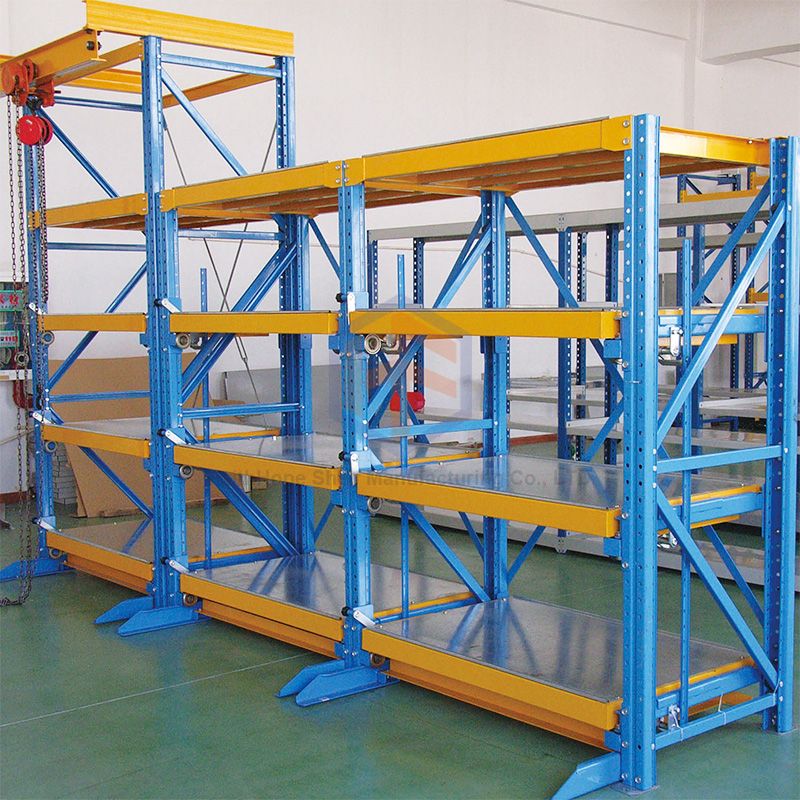What is Mould rack?
In manufacturing and warehousing, efficient storage solutions play a vital role in optimising space, increasing productivity and ensuring the safety of goods. One popular storage system in recent years has been mould racks. Mould racks are specialised storage systems designed to store heavy and bulky items, particularly moulds used in the manufacturing process. In this article, we'll take an in-depth look at what mould racks are, their benefits, design considerations and their role in streamlining industrial operations.
What is a mould rack?
A mould rack, often referred to as a mould storage rack or mould shelf, is a purpose-built storage system designed specifically for storing heavy and oversized moulds used in various manufacturing processes (e.g. injection moulding, die casting, etc.). These moulds are a key component of industrial production and their safe and efficient storage is essential to ensure the smooth running of manufacturing operations.
Mould racks are typically made from high quality steel, making them strong and capable of supporting heavy loads. They come in a variety of configurations and sizes to accommodate different types and sizes of moulds, ensuring that each rack is customised to meet the specific needs of a manufacturing plant.
Advantages of mould racks
Space optimisation: one of the main benefits of using mould racks is the efficient use of vertical space. By storing moulds vertically, they take up less floor space, allowing manufacturers to maximise the use of their warehouse or production area. This is particularly valuable for facilities where space is at a premium.
Easy access: Mould racks are designed with accessibility in mind. They are often equipped with pull-out drawers or sliding racks that allow operators to easily reach individual moulds without heavy lifting or handling. This accessibility reduces the risk of injury and mould damage.
Improved organisation: The correct organisation of moulds is essential for manufacturing operations. Mould racks help to systematically organise moulds, making it easier for workers to quickly locate and retrieve the required moulds. This organisation can significantly improve operational efficiency.
Enhanced safety: Mould racks can withstand heavy loads, reducing the risk of accidents due to overloading or unstable storage. In addition, their design minimises the need for workers to manually handle heavy moulds, thus reducing the risk of injury.
Durability: Mould racks are made from high quality materials to ensure their durability and longevity. They are able to withstand harsh industrial environments and the heavy loads associated with moulds.
Design considerations for mould racks
There are several key design considerations that should be taken into account when implementing mould racks in an industrial environment:
Load capacity: It is critical to determine the required load capacity of the mould rack based on the heaviest moulds that need to be stored. Overloading the rack may result in structural damage and safety hazards.
Rack Configuration: Mould racks are available in a variety of configurations, including single-sided and double-sided racks. The choice depends on available space and the layout of the facility.
Accessibility: Consider how the mould will be accessed. Some mould racks come with pull-out shelves, while others come with sliding drawers. Choose a design that meets your operational needs.
Size and dimensions: Mould racks should be designed to accommodate the specific size and dimensions of the mould. Customisation may be required to ensure a good fit.
Safety features: Employ safety features such as locking mechanisms, anti-tipping measures and guards to prevent accidents and injuries.
Space efficiency: Optimise the use of vertical space to make the most of the available floor space. Consider factors such as ceiling heights and rack arrangements.
Material handling equipment: Assess whether material handling equipment such as forklift trucks or cranes will be required to load moulds onto or unload them from racks. Ensure that these machines have adequate clearance and manoeuvring space.
The role of mould racks in industrial operations
Mould racks play an important role in streamlining industrial operations, especially in manufacturing facilities that rely on moulds for production. Here are some of the key ways in which mould racks improve operational efficiency:
Reduced downtime: Quick and easy access to moulds minimises production downtime. Workers can retrieve moulds in a timely manner, allowing the manufacturing process to continue without unnecessary delays.
Inventory Control: Mould racks help maintain accurate inventory control. With organised storage, the quantity and condition of moulds can be tracked more easily, reducing the risk of errors in production planning and scheduling.
Employee Safety: Mould racks are designed with safety as a priority. By minimising manual handling of heavy moulds and ensuring stable storage, the risk of injury in the workplace is significantly reduced.
Space optimisation: As mentioned earlier, mould racks maximise the use of space, enabling manufacturers to make the most of the available floor space. This is particularly valuable in high-cost property areas.
Product quality: the correct storage of moulds ensures that they remain in good condition, thus contributing to the quality and consistency of the products manufactured.
Cost savings: by reducing the risk of mould damage and improving operational efficiency, mould racks help to save money in the long run.
Conclusion
Mould racks are an essential part of modern manufacturing and warehousing operations. Their role in effectively storing heavy and oversized moulds cannot be overstated. These purpose-built storage systems offer many benefits including space optimisation, ease of access, improved organisation, enhanced security and durability. Careful consideration of factors such as weight capacity, rack configuration and safety features is critical when designing and implementing mould racks in an industrial environment. Overall, mould racks make a significant contribution to streamlining industrial operations, reducing downtime and ensuring the smooth running of the manufacturing process. As the manufacturing industry continues to evolve, mould racks continue to be a valuable asset for companies seeking to enhance their storage and production capabilities.


Comments
0